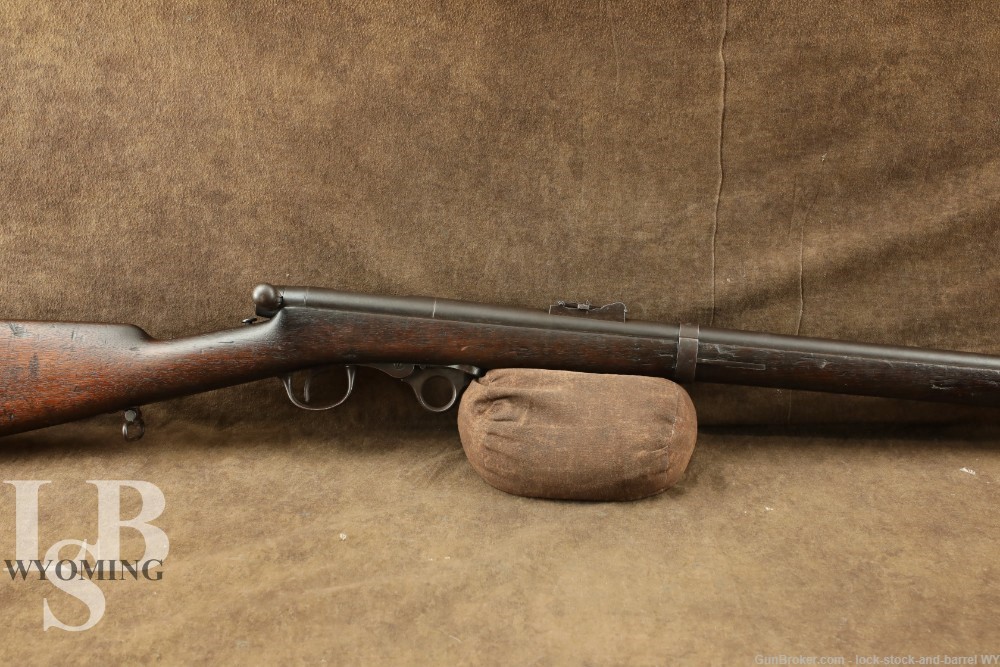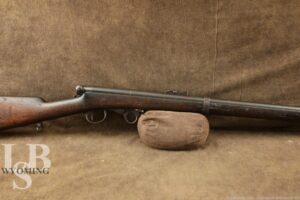
Pre-American Civil War Era Greene Rifle .53 Cal Bolt Action Rifle Antique
SOLD FOR: $1,691.59
WOA#: WY240229RK004
Make: A. H. Waters Armory, Massachusetts
Model: Greene Rifle
Serial Number: 3290
Year of Manufacture: 1859-1860
Caliber: Proprietary .53 caliber paper cartridge
Action Type: Single shot bolt action, underhammer percussion cap
Markings: The left side of the bolt body is marked “3290”. The top of the receiver tang is marked “Greene’s Patent Nov. 17 1857.” The underside of the rear sight ladder is marked “75” followed by an illegible number. The right sides of the middle and rear barrel bands are marked “U”.
Barrel Length: 35”
Sights / Optics: The front sight is a blade set into a barrel-mounted base. The rear sight is a v-notch blade when down and a v-notch blade on a sight ladder when flipped up. The rear sight slide is frozen in place.
Stock Configuration & Condition: The stock has a straight grip, cut out for the included ramrod/cleaning rod, two barrel bands, barrel band with sling loop, trigger guard assembly mounted sling loop, and a metal buttplate with a hinged door for storage. The buttplate is heavily pitted and there are areas of oxidation throughout. There are compression marks, scuffs, and scratches throughout the wood. There are three small cracks on the buttstock, one on each side and one at the heel. The buttstock has multiple chips in the wood, mostly near the toe. The forend is heavily worn, with multiple deep compression marks and chips. There is a chip on the right side next to the rear barrel band. The LOP measures 13.6” from the front of the trigger to the back of the buttplate. The stock rates in about Fair to Good overall condition for an antique.
Type of Finish: Blue
Finish Originality: Original
Bore Condition: The bore is bright and the rifling is defined. There is light erosion in the bore.
In this writer’s opinion, this bore rates 7 out of 10.
Most antique firearms have bores that will show erosion. This is not only due to age but also to the of black powder. When fired, black powder reacts corrosively. NRA Antique Firearm Conditions Standards are quite lenient for bores. In some cases, the NRA standards disregard the bore’s condition for collectors’ firearms.
Overall Condition: Most of the finish on this rifle has been converted to a patina. There are scuffs and scratches throughout the metal. There is blue finish remaining on the bolt, bolt unlock button, and a small amount on the middle barrel band. The receiver and barrel exterior have a thin layer of surface throughout. The barrel bands have oxidation and a patina. The trigger, trigger guard assembly, and hammer have a patina. There is rust in the cut out of the ramrod/cleaning rod. The rear sight is heavily pitted and the slide is stuck. The screw heads show moderate use. The pins have some slight marring. The markings are worn. Overall, this rifle rates in about Good condition for an antique.
Mechanics: The action functions correctly. We did not fire this rifle. As with all used firearms, a thorough cleaning may be necessary to meet your maintenance requirements.
Box, Paperwork & Accessories: None
Our Assessment: The Greene Rifle was the first bolt action rifle to be adopted by the United States military. Designed and patented by Lieutenant Colonel James Durrell Greene just prior to the American Civil War, the Greene Rifle featured an underhammer percussion cap ignition system and ovoid rifling. The most unique aspect of the Greene was its loading and firing sequence, as well as the ammunition. To load the rifle, you first needed to press the bolt unlock button at the top of the tang to release the bolt and pull it back, place a bullet into the chamber, and then ram it forward with the bolt. You would then bring the bolt back and place a special paper cartridge into the breech and ram it forward into the bullet. Then you would lock the bolt by turning the handle to the right, cock the hammer, place a cap on the nipple, aim, and pull the trigger. The paper cartridges for this rifle are unique in that the powder is in front of the bullet. That is because if you are doing things in the correct order, there should already be a bullet from the previous, fired, cartridge rammed into the firing position. The bullet at the rear of the paper cartridge was to be used as a gas seal. So, technically the rifle is always loaded with two bullets, but only firing one. To get a better idea of how the rifle works, the YouTube channel Paper Cartridges has a great video of the loading and firing of the rifle as well as the history. The rifles were not popular and the United States Army contract was for only 900 rifles, which saw very limited service during the American Civil War. This example has some wear to its stock, with a few deep compression marks and gouges throughout. The buttstock has a few small cracks near the buttplate as well. The finish on the metal has mostly turned to a patina, though the bolt, bolt unlock button, and middle barrel band retain some of the original blueing. There is a thin layer of surface rust throughout. The bore is bright with defined rifling, though it could definitely use a deep cleaning. These are very scarce but interesting rifles and an important part of firearms history. Please see our photos.
-99



